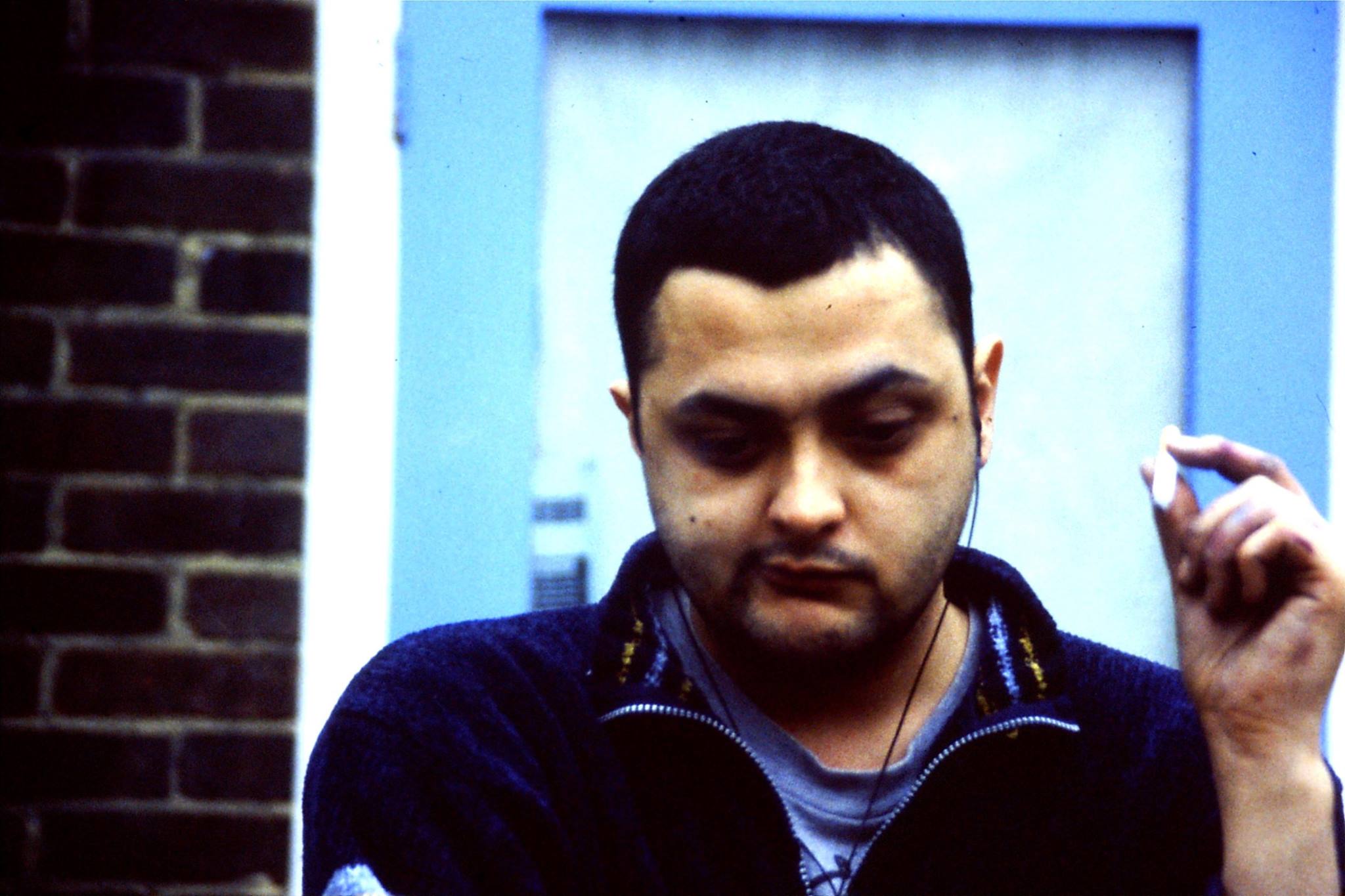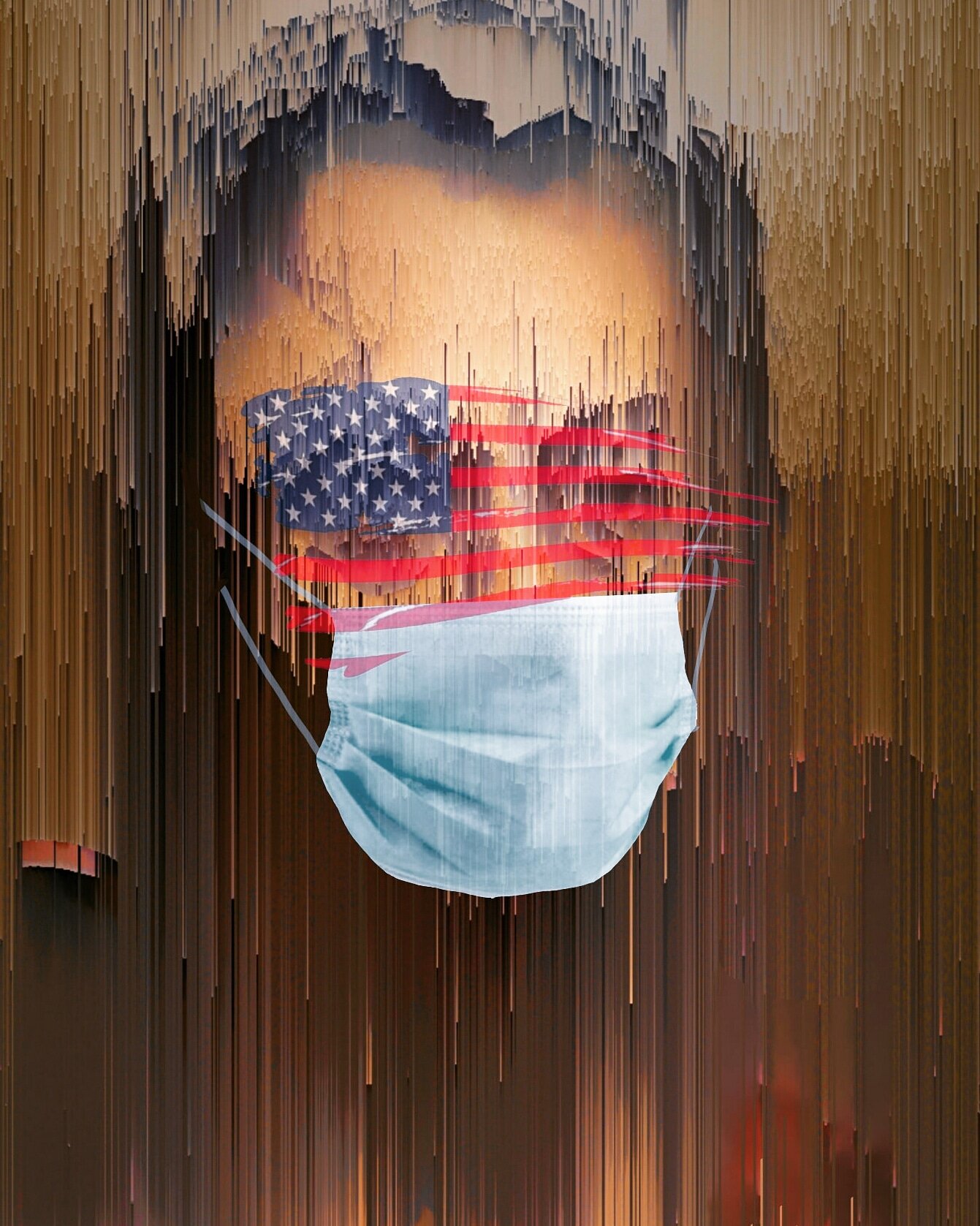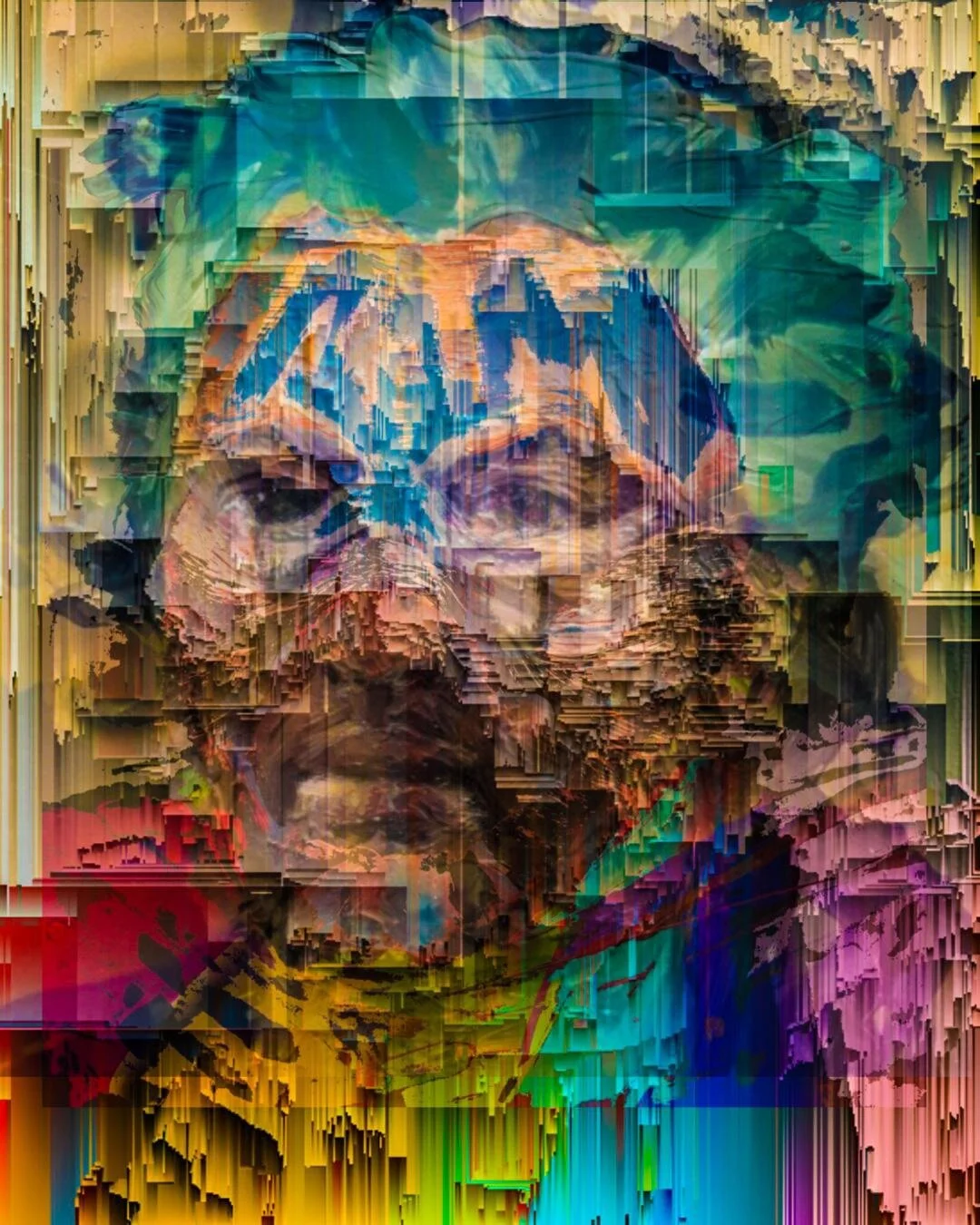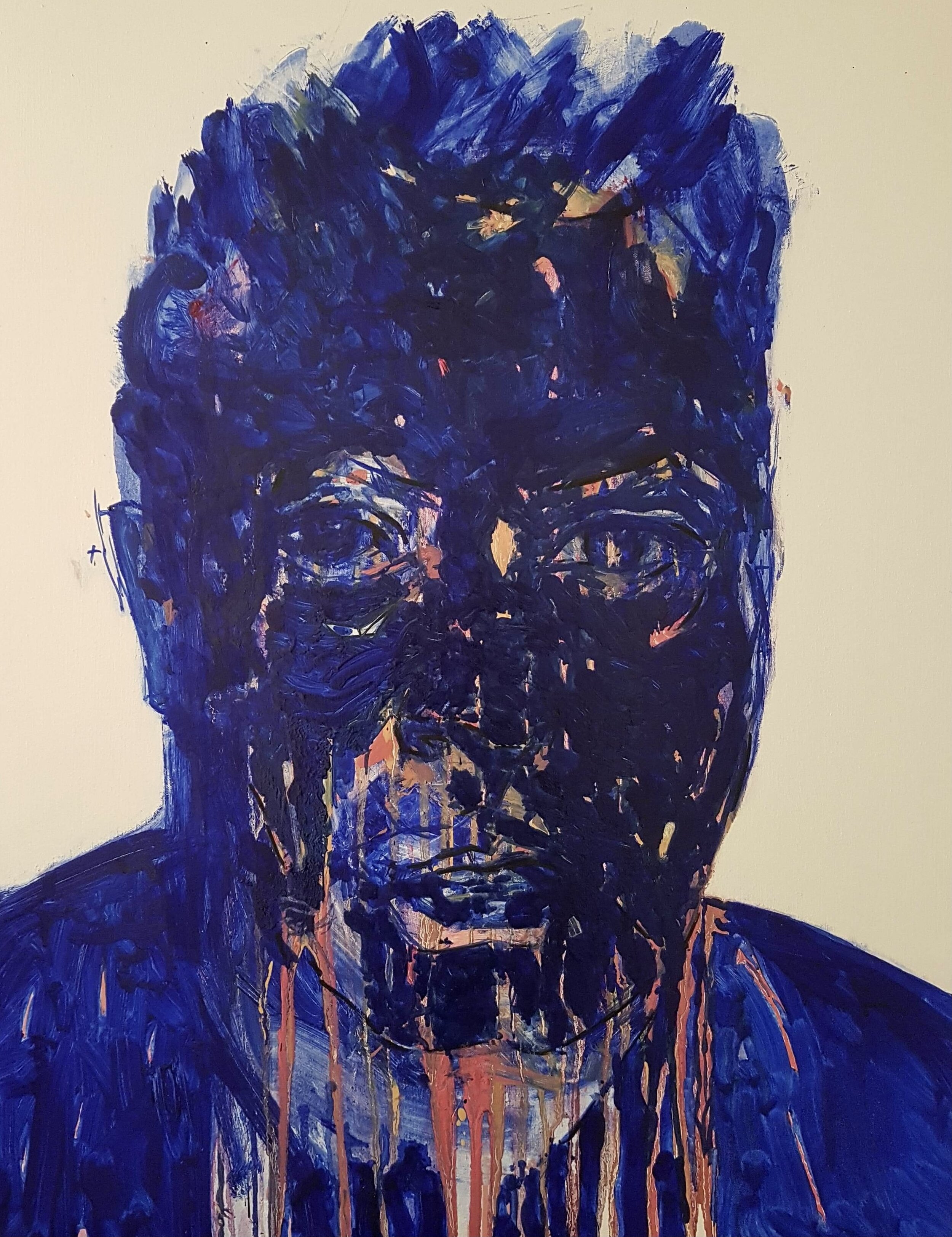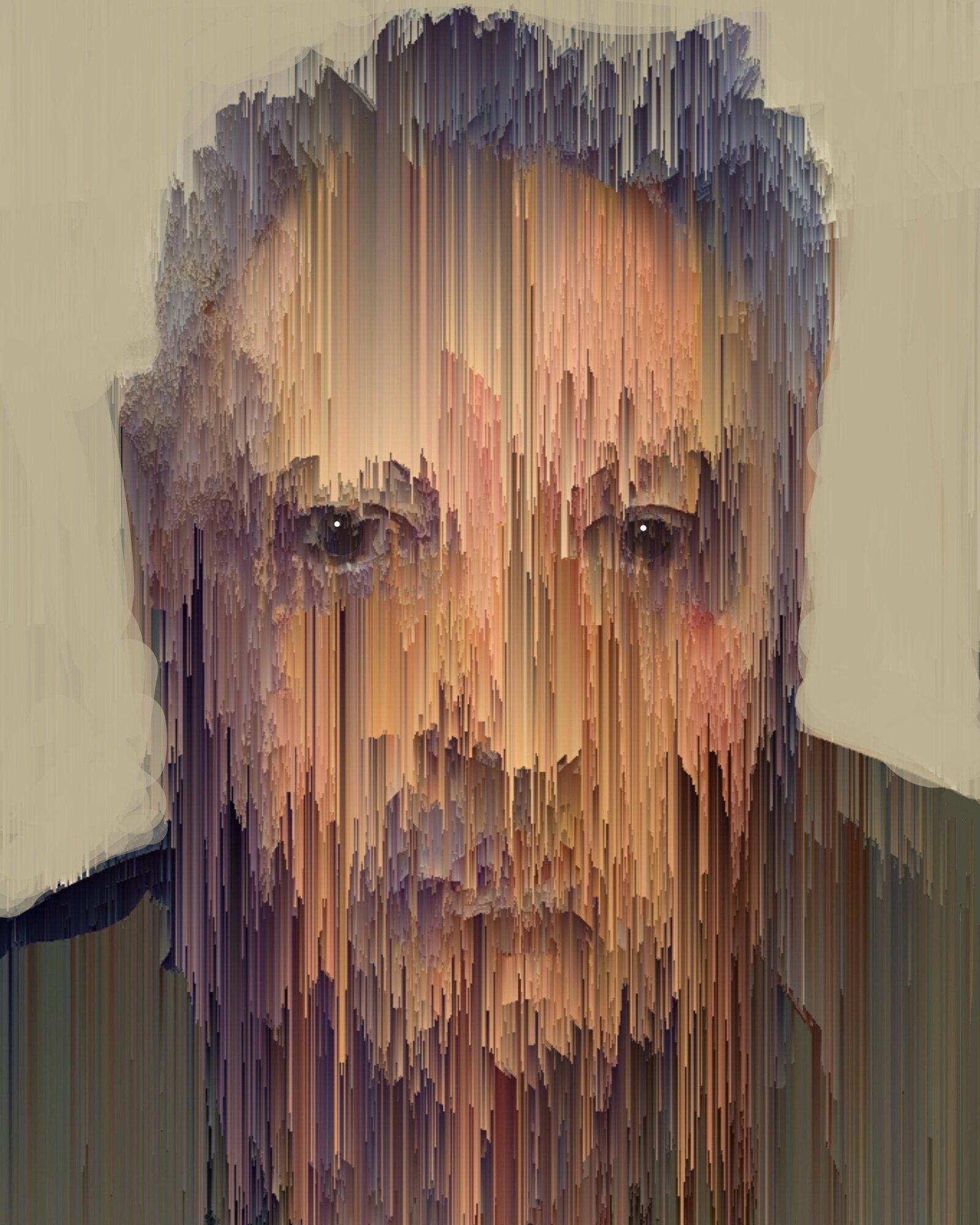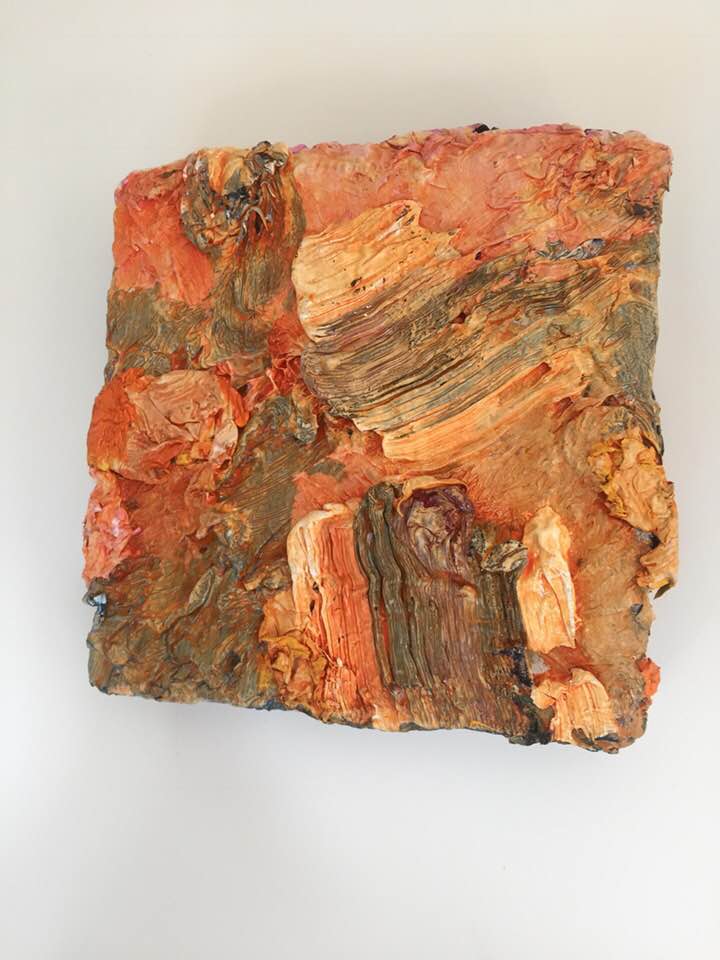
Kim Wan in front of his painting in the studio
Photo credit: ©Annie Morris
Kim Wan (b.1970) is a British artist of East Asian Polynesian and Western European heritage. Wan’s artworks are all painterly – whether it is the obsessive exploration in his series of self-portraits, or the heavy impastoed, painted surfaces on found objects contributing to large-scale major installations. He made a lot of hip hop inspired graffiti during the 1980s, and the speed and power of spray-painting has remained a strong thread throughout his art career.
In the UK, Wan has worked with museums and institutions such as the National Portrait Gallery, TATE Modern, the Institute of Contemporary Art and the National Gallery. He is a selected artist by international committee at the Florence Biennale and is represented in the Saatchi collection. Exhibiting regularly in New York City, recent shows also include Art Basel Miami and range from Berlin, Moscow and Beijing to the Louvre, Paris.
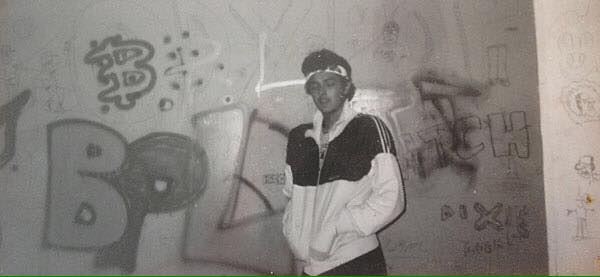
Kim Wan c.1983 Hastings
Selected past exhibitions and events
- SCOPE, See.Me, Miami Beach, USA
- ‘Et Tu Art Brute?’ Andrew Edlin Underground Gallery, NYC
- Cultural Traffic’ publication fairs, NYC, Los Angeles & London
- Rugby World Cup, England 2015, Opening Ceremony
- Richelieu balcony, La Louvre, Paris, France
- See Me Takeover, digital collaboration, Times Square, NYC
- SWIM film by Amy Sharrocks, Somerset House, London
- SCOPE, Miami Beach, USA, See.Me
- Opening ceremony UEFA champions league final- Wembley stadium
- London 2012 Olympic Opening Ceremony-Isles Of Wonder by Danny Boyle
- TATE Modern Tanks and Five Years Gallery
- Westminster Reference Library, London
- Institute of Contemporary Art, London
- Rebecca Marshall & the London Film School
- National Portrait Gallery, London
- University of Brighton
- ACInstitute, New York City
- Sanlun Yishu Global Project Beijing China
- Ania Bas and Walsall New Art Gallery, England
Winchester School of Art, 1998. By kind permission: copyright-Alastair Eales
See.Me Interview with Kim Wan
TELL US ABOUT HOW YOU DECIDED TO BECOME AN ARTIST AND WHY?
My personal belief is that I’ve always been an artist. I think people are born with a genetic disposition towards being an artist and so in relation to that idea, I wouldn’t say that I ‘decided’ to become an artist. I suppose I decided to pursue a career as an artist after my first year at my foundation college course in art where I became crucially aware of the creative aspects of making as a necessity for my psychological survival. So, I decided on university, based on that personal realization. I didn’t have a choice in the matter, really.
WHAT INFLUENCES YOU THE MOST WHEN YOU ARE IN THE PROCESS OF CREATING A NEW ARTWORK?
I don’t really know what influences me. I could give a really crap answer like it’s my surroundings or what I look at on TV, but I don’t really know to be honest. I just make the work now and obviously I make self-portraits, which is not difficult to work out. I suppose it’s trying to do something new. I always feel that I am doing the same thing, using the same techniques and stuff. Recently, I’ve been investigating new materials and trying to explore different ways of applying paint. I suppose that’s where I am with my work at the moment, it’s about honing my craft, which sounds bad, but it’s true. I can also say that I have a bit of an obsession with looking at the sky and the sea where I live, the horizon is one of nature’s defining lines. In summary, a lot of visual information goes into my subconscious, and then a kind of catharsis develops through my consciousness, so I guess that whatever goes into my eyeballs, is what I paint.
Looking back to the 1980s, Hip Hop came to the UK from NYC and filtered down to our school. We developed ‘crews’ and held dance battles, every Saturday meeting at our local disco which became the popular choice for many an aspiring break-dancer. I made large-scale spray paintings – or graffiti – on walls. You can still see the faded artworks to this day. However, I was a young parent and had to rise to the challenge, so university would have to wait.
At school, I was good at music and was encouraged by my teacher to pursue my bass playing and music writing, which eventually led to releasing a 12” white label record, “Catch 22”, under the name SYNCRO ART. This led me into the rave scene and acid house, going to free parties and all-night events in London and the South-East. This was all in the early 1990s, which changed how I looked at the world. In 1992 came the perfect storm of pursuing art, rave culture and my father passing away, led to an irreversible life change – for the next four years I painted incessantly, alone in my flat, completely immersed in my work and the life it gave me.
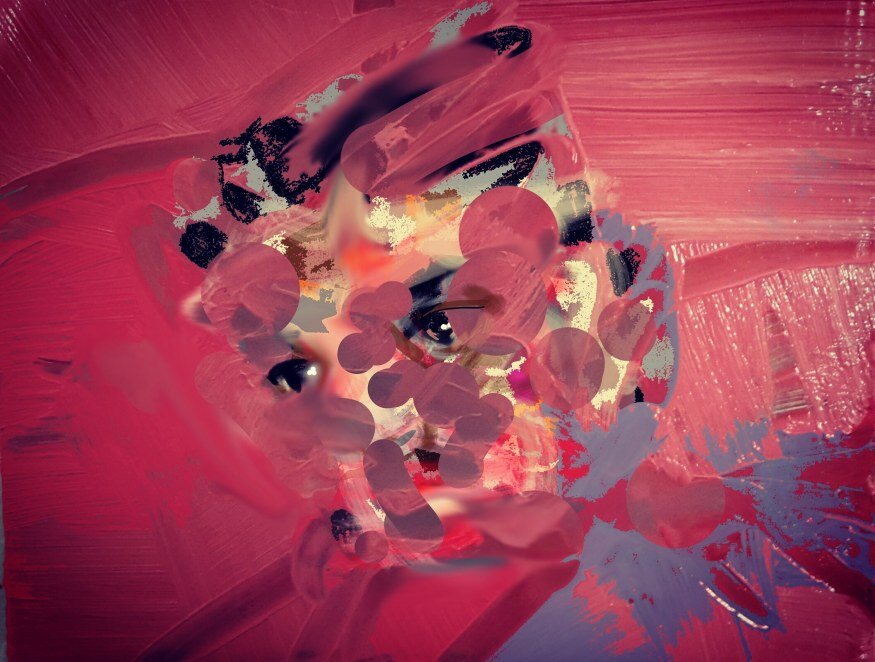
I fell into the underbelly of Hastings, with its artists, musicians and bohemian lifestyle. In 1996, after an Art Foundation course in Hastings College, I eventually went to university, Winchester School of Art, following my interview in which I carried the huge pile of canvases and drawings I had made in those four years. Most of those canvases are now either lost or destroyed. At Winchester, I learned all I could and challenged the status quo. In my first year, I was in a group exhibition with Frank Auerbach, Leon Kossoff, David Hockney and RV Kitaj; before that I had not realised just how privileged the School was, and therefore how privileged I was in being able to exhibit with my painterly heroes.
After university, I returned to Hastings with renewed vigour. My life as an artist again brought hardship and sacrifice, which I endured with self-belief, instilled by my teachers and my friends. In 2000, I held a small exhibition in my flat, to which the artist Colin Booth attended, offering me my first one-man show. He also advised me to go and see a man in Tunbridge Wells from the Arts Council of Great Britain, where I was awarded my first grant, which led to the 2002 ‘Off the Edge’ exhibition at Electro Studios in St Leonards. During this time, I met Annie Morris, who to this day has stood by me. This show launched my artistic career, of meetings, grants and professional development opportunities.
Since then, I have worked hard in the studio, producing a great deal of work which has led to many exhibitions, in a number of countries. In 2010, I was offered my first solo show in Chelsea, Manhattan; this established me in NYC. It has become a good place for the type of artworks that I produce.
My exhibition list now includes: Bejing, Moscow, North America, Europe, the UK – and exhibiting alongside luminaries such as Van Gogh, Wolfgang Tillmans, Bob & Roberta Smith, Gavin Turk and Amy Sharrocks. Locations include One World Trade Centre, NYC; Times Square, NYC; Scope Art Fair, Miami Beach; Tate Modern Tanks, London; National Portrait Gallery, London. Annie and I have travelled extensively to the shows and worked with museums and galleries internationally, notably showing at the Louvre, which opened on Bastille Day 2015, drinking champagne on the Richelieu balcony…
ARE THERE ANY ARTISTS YOU ARE INSPIRED AND INFLUENCED BY?
Well, in all honesty, I can learn more about art from the most mundane of situations than staring at a masterpiece for ages, but here goes….
Academically, the usual suspects rear their (literal) heads, Francis Bacon, Frank Auerbach and the London School. I admire Mark Bradford and Sterling Ruby at Hauser and Wirth for the quality of their surfaces in their work. I’ll look at Jenny Savile and Lucien Freud for technique. Glenn Brown and Chuck Close display technical brilliance and different ways of seeing. I love Julian Schnabel for audacity, Cy Twombly for intellectual input and mark-making. Film-wise, Quentin Tarantino, Nicholas Winding Refn, Martin Scorsese, Taika Waititi, give me relaxation from having to think with my eyes.
WHAT WAS, OR IS, AN ARTWORK YOU ESPECIALLY ENJOYED CREATING AND WHY?
I don’t know if the term ‘enjoy’ is appropriate to making art… it’s taken me a long time to break free from the prejudiced mindset of ‘As a fine artist I must only work in traditional media’. As a result of adopting new working methods, I quite like the stuff I’m doing at the moment, which uses graphic techniques applied to my oil paintings – I use digital applications and overlay drawing techniques to manipulate the image.
The ‘Resist’ artworks started off as a painting but ended up as digital works and prints.
I like working digitally because of the instantaneous method that you can work on them on an iPad- it saves a lot of time. I work in my sketchbook and enjoy sketching, but for some reason I stopped doing so recently. I think that’s because of lockdown. I’d normally be traveling, or outdoors where my sketchbooks, which are an “on-the-go type of portable studio”.
I’ve actually been painting more expansively during lockdown by just not doing anything else, so it’s really weird to just make paintings. I have this constant low-level focus in the background and when I say ‘background’, I mean in the back of my mind – a low-level anxiety on how to do something painterly. I think that’s where a lot of my problems come from, in terms of painting. I try to find solutions, but I have no formula, no tried and tested method of actually finding and making a solution. Somehow though, solutions do come about when I’m painting…
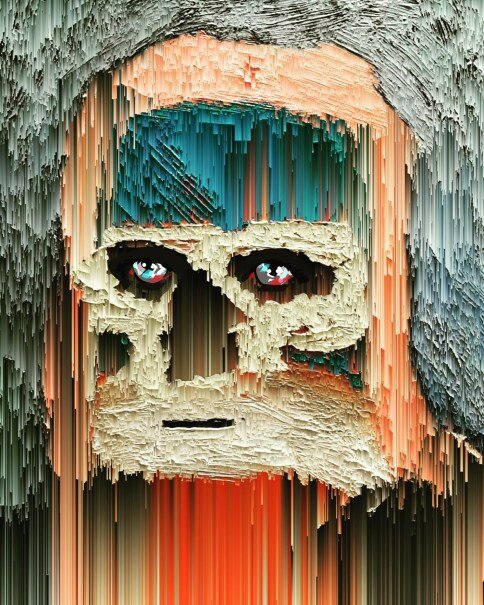
DOES YOUR WORK RELATE TO IDENTITY THEMES? IF SO, HOW?
That is a BIG QUESTION. It’s definitely about my identity and is a lifelong pursuit. Brexit and the rise of the far-right nationalist movement has caused me to experience direct aggression which is racially motivated against my person. I’m mixed-race and so am always unsure of what the appropriate response is, plus lockdown has caused poor mental health through isolation for a lot of people, causing more societal unrest. I guess everyone is having identity issues right now. This interview is good therapy, because I’m having to work through issues of recent times in a word format; that is, in the cathartic process of writing-down my experience. Having to be mindful about my self-protection in physical terms is a good reason to keep fit and play sports, which I do with great enthusiasm and regularity. Fear is a good motivator and keeps me disciplined. A lot of the introspection and looking at one’s appearance is psychological preparedness for going out into the world at large, on so many levels.
TELL US ABOUT YOUR TECHNIQUE, MEDIA, AND ARTISTIC PROCESS AND WHY YOU CHOOSE THESE?
So firstly, I construct my canvases. I have two measurements I work with: 20 x 25 cm and 70 x 90 cm. I take a long time to make them, because one of the most important things about my work is the surface of the canvas that I paint on. I’ve created a method of making surfaces where the oil paint sits on it in a certain way. I stretch canvas over wooden structures and then I prime them with thick acrylic, then I wait for that to cure and then coat it with silver spray-paint. When the surface is dry, it is ready for applying oil paint. I then make my paintings, photograph them and draw over the top, using digital applications. I have been well-versed in using oil on canvas for decades now. The digital applications and techniques have arrived full circle from my early days of using graphic techniques in my artwork and are lightning fast in terms of working the image. Combined, this results in a marriage of slow, traditional fine art disciplines and fast technological processes.
Also, just to say I’ve been painting with oil paint for a long time and really the reason I like using oil is because the gesture, or the mark-making process, fascinates me. I stamp my signature style (akin to signing one’s name) indelibly, when I apply the paint to the canvas or in charcoal or pencil because the material is malleable and soft. The mark-making process is an individual’s own style of making artworks. Every person in the world has their own way of drawing or handwriting. Working with those materials also lends itself towards the act of looking with the eye and the brain. The hand is engaged and renders the subject matter onto a surface, like paper or canvas. This three-way process of looking and reflecting on the subject renders the image onto canvas. The observer again looks at the canvas then, looking back at the subject, applies paint or materials using the hand.
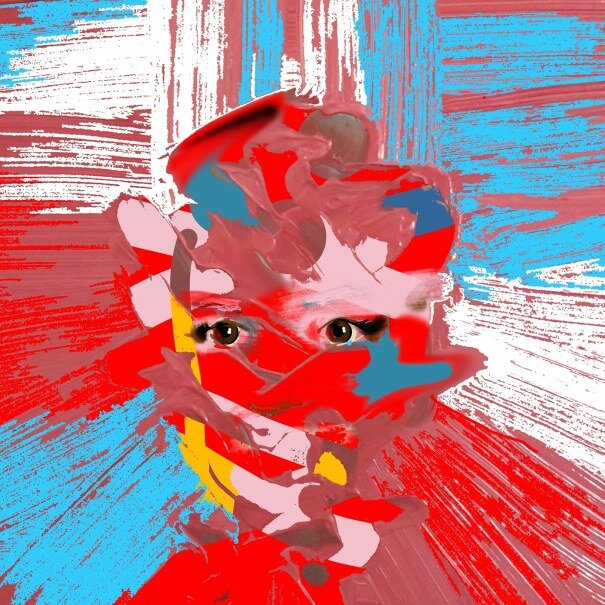
With my self-portraits I’ve come to learn over time how to look at myself and deconstruct the image. It’s a good discipline to keep reworking the image. It’s not about representing what ‘I think I look like’, it’s about representing my physical body – the skull, flesh, blood, skin, hair, doesn’t change fundamentally. It is the physical reality of who I am; but also, at the same time, for some reason and I can’t explain it, I’m able to confer my psychic or psychological state or my feeling or mood or how I’m thinking and there is definitely some projection going on there. However, the fascinating thing for me is that everybody that knows me and looks at myself portraits say “yeah, that’s Kim but every portrait is a different Kim-but it’s the same Kim”. I see people who don’t know each other, and they also say the same thing, they say “you’ve done loads of portraits and they all look like you, but a different you every time.” Almost like they paraphrase each other. There’s something deep going on here, it’s a deep connection.
I’m not interested in getting standard facial emotions – happy, sad, angry, etc. It’s not like I’ve got all these different emotions in my paintings. There is something else present there that I’m able to transfer into paint. I think that Frank Auerbach is able to do it using really heavy surface paint to convey the concept of “the spirit in the mass”. He’s trying to capture “something other” and render it in paint. In that rendering, that’s where the transference of something non-physical – an invisible energy – transfers into the paint. It may be possible that I’m able to render something similar of myself onto canvas. Maybe a combination of gesture and objective observation. This rendering of myself, a kind of spiritual psychic state, I guess, with the bipolar mood swings, depression, paranoia and all those things that are encapsulated inside my head and inside my body: I’m able to take that and render it onto canvas – an exchange from looking at myself in the mirror and applying paint onto canvas and then looking again and concentrating on capturing the image in one sitting – that is the crux of what I’m doing.
With the big impasto-ed paintings there is definitely something subconscious and more landscape orientated, but I think there’s something about those paintings which have the same principles of rendering paint onto canvas, so it becomes an energy, something transformative… but I don’t know what is called.
WHAT DO YOU HOPE VIEWERS WILL TAKE AWAY FROM YOUR ARTWORK?
I wouldn’t dare to presume about what viewers would or do take from my work, but I would perhaps make some suggestions: that there is a sense of a shared experience; something humanly recognizable – or a connection that’s recognizable – but a person wouldn’t necessarily know why it’s recognizable. Especially when it comes to the heavily painted impasto paintings and the larger artworks. Why do those paintings work? They shouldn’t work on the level that they do.
Sometimes I’ll see a painting that I made years ago, and my memory will jump straight back to that point in time again, as if I’m standing back there where it was created. It’s almost like I’ve been able to encapsulate that moment in time. I think I’m able to render something of a snapshot of existence.

DO YOU HAVE A DREAM PROJECT? WHAT MIGHT THAT BE?
I would actually like a retrospective in a museum – a validation, with curators and academics and people who know what they’re talking about, to actually take what I’ve been doing all these years and actually analyze it properly and put it into a larger context. To have the work reviewed in an academic sense and recognized by a major artistic institution. I’d like to see whether my work fits into any art history canons.
I suppose if I had a dream project, I would be given a large space somewhere for a few years to make large-scale works, with no limits on materials.
Kim Wan: Paint Skin, an essay by Alastair Eales
To appropriate the words of Marshall McLuhan: “The medium is the message”. In the case of Kim Wan, rudimentary equates immediacy; this is an artist who paints first and asks questions later!
Kim Wan’s work is wonderfully rudimentary. It is rudimentary, in the sense that it is about the fundamental blocks that constitute a medium – oil paint – and it is about combining that with an idea of what is ‘inside himself’. Basic stuff. Paint and the surface which it is applied to, which in turn form the warp and weft of the ‘‘World according to Wan’. Wan’s World becomes the world within his skins, and his skins can cover everything.
Wan enjoys paint! Great volumic clods of smeary paint – gathered together and layered – twirled, slathered hastily, and yet always controlled and unadulterated. Paint is skin – it sits on the surface and (usually) alludes to form – but in Wan’s case his painterly skin holds a beating heart; it is his personal message to the world.
Kim Wan’s skill lies in the combination of the physical skin of paint, and its application, to form interesting and unexpected relationships. His paint describes form, and its sheer volume becomes form; it becomes an object of “an object”. Slathering, stratified clods that form landscapes of paint, that make skin surfaces. Wan’s topography of paint skin and its inferred meaning encapsulate everything in the pliable congregation of an ever-shifting, evolving and borderless environment. It contains something limitless; it’s the skin of something infinite. The ground onto which his environments adhere could just as easily be a canvas as a concrete floor or an old sideboard. He’s a painter who goes over the edge between art object and everything else. He is an artist with skin in the game.
This makes his environments vulnerable and violent, on edge and paradoxical; everything becomes an autobiographical façade; awkward and brilliant, difficult. Wan’s work rests on this difficult knife-edge between contained self-love and actual, recognisable, unbound genius.
There is a danger, of course, that, in his exuberance, his work could fall on the side of self-indulgence; that he is implicitly saying that his art, that he himself, really is everything. However, this indulgence allows a chance of a catalyst – there appears to be a symbiotic relationship between the ‘indulgence’ and ‘genius’; both are needed, both are valid and combined, both aspects yield results!
The art critic and writer, Sasha Craddock remarked of Wan’s painting back in 1998, and I paraphrase:
“Kim paints with such energy that one may think the result could only be a mess, but in this case [points to very large painting of thick, loose gestural marks in ultramarine and pink].There is a fine line between utter indulgence and brilliance – Kim paints like a maestro – at least in this painting, maybe his other work is awkward indulgences?”
Squirting £250 of oil paint onto a canvas, all in one go, is an indulgence: a self-gratifying outlay of artistic spending power.
So I am going to suggest that awkward solipsism and brilliant outlay exist at the same time. I’m going to propose that Wan’s best work is his most awkward and indulgent work; that it is a brilliant form of compromised genius.
It is Kim Wan’s exclusive focus on the painterly that drives the violence, the verve and vigour of his paintings and at the same time echoes his vulnerability and vacillation within a certain tunnel vision. He is an artist caught between flesh and sinew, between pigment and medium; an artist who revolves around a helix of what it is to be everything inside a human skin but who then compromises that with his chosen medium; he ends up articulating being human in paint and so everything becomes boundlessly alive within his paintings’ thick skin.
By revolving around an indulgence of self – coupled with an articulation of that self-satisfaction within the outlay of an expensive new artificial skin, and by trying to go beyond the limits imposed by this colourful artistic paint surface, he has also found a way of going beyond his own skin.
And all of this, by simply slapping paint about!
By Alastair Eales
(Editorial essay support: Phil King)
Education
- 1998 Winchester School of Art, B.A.( hons.) Fine art- Painting
Awards and Grants
- BAFTA award Olympic Opening Ceremony London 2012
- Florence Biennale, Selected artist by International Commitee, the office of the President of Italy, and UNESCO
- TATE MODERN TANKS Five years gallery
- Workweek prize, shortlist, five years gallery, Artlicks weekend.
- TASTY MODERN, Selected for Whitechapel Gallery’s First Thursdays Top 5 Exhibitions
- Bursary award, Arts Council London
- Exhibition award#3, Arts & Business South East
- Professional development award, Princes Trust
- Exhibition award#2, Arts & Business South East
- Exhibition award#1, Arts & Business South East
- Mentoring grant, Arts Council England South East
- Exhibition award, Decibel South East, Arts Council England
- Professional development award, Arts & Business South East
- Exhibition grant, South East Arts, Arts Council England
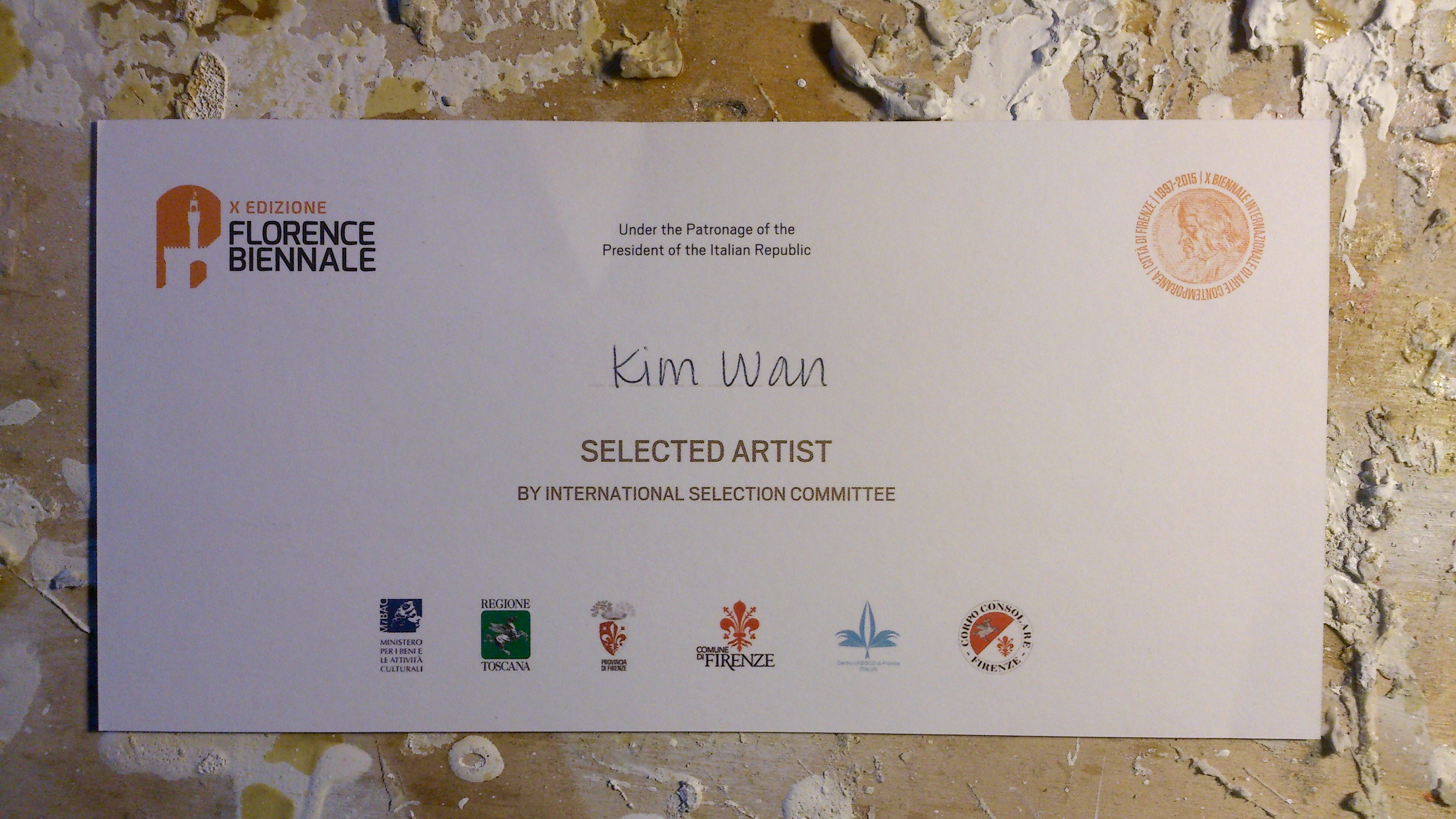
Professional development
- EAST professional development, funded by Arts Council London
- Mentoring programme, funded by Arts Council England
- Creative Routes ( Palmer-Hamilton partnership), part funded by European Social Fund
- Artist – consultant on Arts Strategy, South East Arts, Arts Council England
- Consultation report, Arts Council England National Office
- Development Forum member, Arts & Business South East Arts Member, Arts & Business South
Publications
- THIS IS NOT PUBLIC. Five Years Publications: Public Series no. 5.ISBN 978-1-903724-11-8
- KIM WAN, Westminster reference library, London, UK
- RANDOM WORKS, Westminster reference library, London UK
- THIS IS NOT A SCHOOL. Five Years publications ISBN 978-1-903724-07-1
- (IM) POSSIBLE SCHOOL BOOK:AS FOUND.APPENDIX. ISBN 978-1-903724-08-8, Five Years Publications, Tate Modern library
- VIOLENTS, Winchester School of Art library, Hampshire, UK
- VIOLENTS, The School House, ArtworksMK , Great Linford, UK
- PAN-DEMONIUM by Gilian Whiteley, art history essay featuring work by Kim Wan ISBN-13: 978-0984130900
Online Reviews and Press
- AC Institute A Kim Wan solo show Kim Wan solo show Manhattan
- AC Institute [Direct Chapel] – In A Star Orbit and Pan-demoniumdetail of Kim Wan’s drawing, literature on Bricolage Kitchen curated by Gillian Whiteley
- Amazon.co.uk Pan-demonium by Gilian Whiteley, art history essay based on the show in AC Chapel NYC, featuring work by Kim Wan, on Amazon Books.
- Art Cards London Brings you to Art
- Art Cat The Opinionated Guide to New York Art.
- Art Forum The online edition of Artforum International Magazine.
- Artrabbit International contemporary art
- Art Slant Contemporary art network
- artfacts Inside information
- Artipedia Artipedia is the new official encyclopedia for art fans as much as professionals.
- ArtLyst London Art Network
- Arts & Business Cultural investment agency
- Artslant-Kim Wan talk scroll down for information about the talk at AC Institute
- BBC Southern counties -This is not graffiti anymore Graffiti expo Brighton
- Close but no cigar Initiative set up to question the role of the artist and art institution
- Drawing Connections in Siena Siena Art Institute
- Ethos World promoting Graffiti and spraypainting.
- Five Years unfunded collaborative artists’ project in Hackney
- Interface a-n review of Surface Gallery International Postcard Show 2013
- Kim Wan Art Kim Wan Arts website
- New York Times review of Postcards From The Edge 2018
- National portrait gallery four corners Kim Wan’s self portrait
- Rhizome site.Decision Making and Output , A talk by artist Kim WanTalk at the AC
- Rhizome-at the New MuseumRhizome is located within the New Museum at:235 Bowery, New York NY 10002
- Rise Art Artist profile-Kim Wan
- Saatchi online gallery- Kim Wan Kim Wan , artist’s page on the Saatchi online gallery
- SCOPE MIami Beach 2013 Exhibiting at this prestigious art fair December 3-8
- See.Me Kim Wan to exhibit with See.Me at Scope Miami 2013
- SWIm event 55 swimmers join artist Amy Sharrocks for a swim across the waterways of London
- The Village Voice- NYC publicationNew York newspaper
- This Is Not A School Five Years Gallery present……proposal no. 47, Kim Wan
- Van Gogh one minute exhibition, New Art Gallery, Walsall Kim Wan and Van Gogh on the same wall
- Whitechapel Gallery First Thursdays Late night art on the first Thursday of every month in east London

